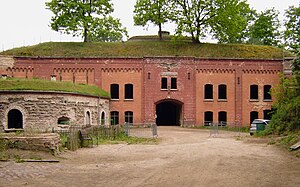Fort Hahneberg
| Fort Hahneberg | ||
|---|---|---|
|
Kehlkaserne in the fort |
||
| Creation time : | until 1888 | |
| Conservation status: | restored | |
| Construction: | Brickwork | |
| Place: | Berlin-Staaken | |
| Geographical location | 52 ° 31 '18.5 " N , 13 ° 8' 17.9" E | |
|
|
||
The Fort Hahneberg , on the western edge of Berlin situated, is considered one of the last fortifications to Prussian style in Germany . It was completed in 1888 after six years of construction and has been open to the public since the late 1990s.
history
After the Franco-Prussian War of 1870/1871, four forts were planned to protect the Spandau armaments center as part of the Spandau Fortress , but only one of them was built, as the development of artillery, especially the introduction of explosive grenades , meanwhile had this type of fortification useless.
The excavation of the Hahneberg ( 66 m above sea level ) and the sinking of the fort led to the hexagonal detached work with an area of 450 m × 170 m. It can hardly be seen from the outside.
After its completion, the facility served as a barracks and central archive for military medicine until 1945 , so it was mainly used for military purposes. During the Buchrucker putsch on October 1, 1923, the fort together with the Spandau Citadel was briefly occupied by putschists who had to surrender to regular Reich defense units. From 1924 to 1934 the Flugtechnische Verein Spandau 1924 e. V. some structures of the fort in order to build gliders there.
After the end of the war , parts of the brick walls and structures were broken out and taken away as building material for the reconstruction of Berlin. On the other hand, rubble , and later construction rubble, was deposited on the site . This increased the eponymous mountain up to 87 m. Until the fall of the Berlin Wall in 1989, the fort was located in the area of the barriers at the Heerstraße border crossing and has only been accessible to the public again since 1990. Since 1993 it has been run by the Arbeits- und Schutzgemeinschaft Fort Hahneberg e. V. (ASG Fort Hahneberg) supervised and renovated piece by piece in voluntary work.
For the film Inglourious Basterds by US director Quentin Tarantino , the system served as a backdrop for some scenes.
natural reserve
The fort is an important bat quarter. In 2009, the buildings and the surroundings of the fort were designated as a nature reserve and a fauna-flora habitat , as this is where the great mouse- eared bat, along with other bat species, have their winter quarters and their summer residence. In addition, the dry and semi-arid grassland developed on the adjacent areas as well as the ravine forest emerging in the ditch are particularly worthy of protection. The operating association regularly organizes nature and bat tours on the fort site and also takes part in the annual Open Monument Day and a Fort Day organized by Germany and France .
See also
literature
- Manfred P. Schulze: Fort Hahneberg. The only outer fort of the Spandau Fortress. Research on the history of the city and fortress Spandau , Volume 1, Heimatkundliche Vereinigung Spandau 1954 e. V., 2004. ISBN 3-00-014624-5 .
Web links
- Arbeits- und Schutzgemeinschaft Fort Hahneberg e. V.
- Senate Department for Urban Development Berlin: NATURA 2000 area Fort Hahneberg
- Recordings from Fort Hahneberg
- Entry in the Berlin State Monument List
Individual evidence
- ↑ Berlin Calendar 1997 , Luisenstädtischer Bildungsverein, 1996, ISBN 3-89542-089-1 , p. 111.
- ↑ Declaration on the protected area
- ↑ Guided tours and events in Fort Hahneberg . Retrieved January 7, 2019.




